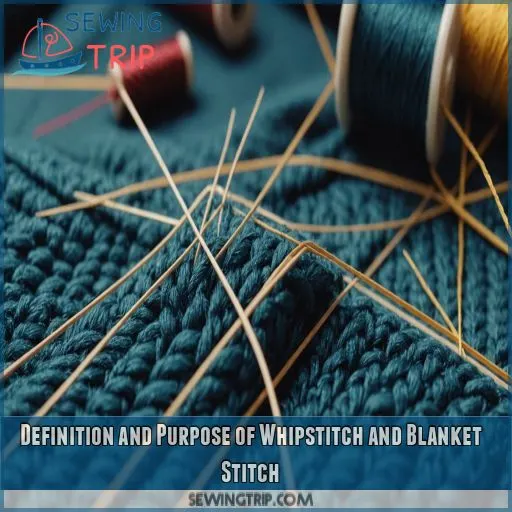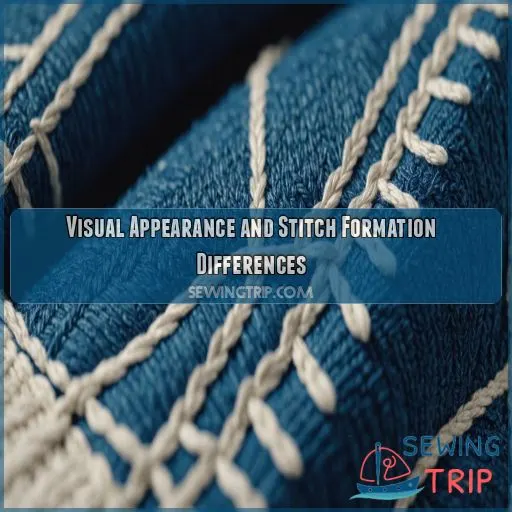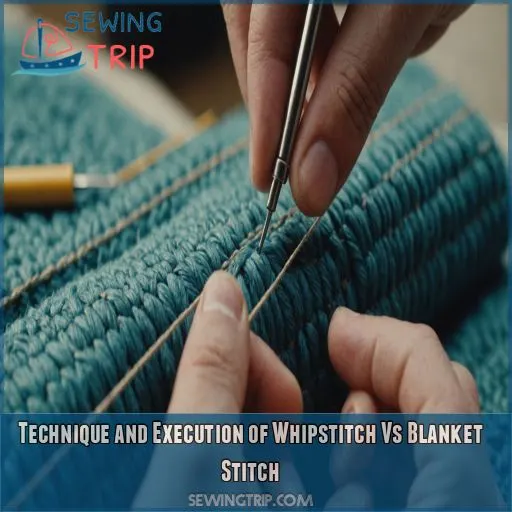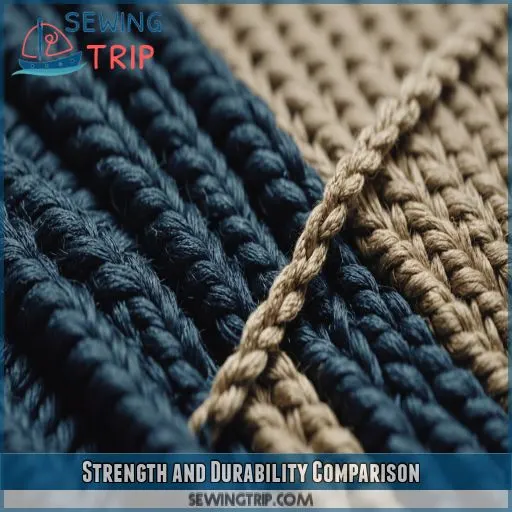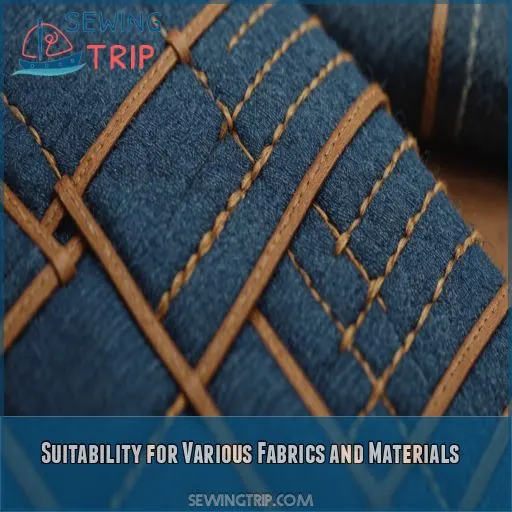This site is supported by our readers. We may earn a commission, at no cost to you, if you purchase through links.
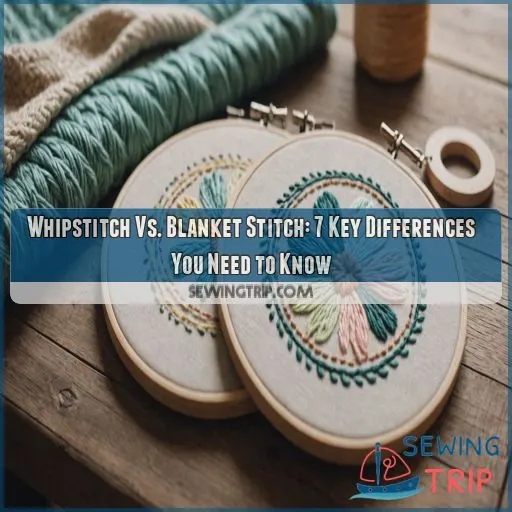
The whipstitch is your speedy sidekick, perfect for quick fixes and lightweight fabrics.
It’s like a spiral staircase of thread, wrapping diagonally around edges.
The blanket stitch, on the other hand, is the heavyweight champion of durability.
It creates a fence-like pattern that’s both sturdy and decorative.
While whipstitch is your go-to for invisible seams, blanket stitch shines on thicker materials and as a bold embellishment.
Choosing between them?
Consider your fabric, project needs, and whether you want your stitches to steal the show or play it cool behind the scenes.
Table Of Contents
- Key Takeaways
- Definition and Purpose of Whipstitch and Blanket Stitch
- Visual Appearance and Stitch Formation Differences
- Technique and Execution of Whipstitch Vs Blanket Stitch
- Strength and Durability Comparison
- Suitability for Various Fabrics and Materials
- Decorative Aspects and Aesthetic Appeal
- Time Efficiency and Skill Level Requirements
- Frequently Asked Questions (FAQs)
- Conclusion
Key Takeaways
- You’ve got two secret weapons in your sewing arsenal: the whipstitch and the blanket stitch – and now you know the difference between them! The whipstitch is your speedy sidekick for quick fixes, invisible seams, and lightweight fabrics, while the blanket stitch is the heavyweight champion of durability, perfect for thicker materials and bold embellishments.
- Don’t be afraid to get creative with your stitches! Both the whipstitch and the blanket stitch can be used as decorative elements to add colorful accents, texture, or eye-catching patterns to your projects. Experiment with different thread colors and thicknesses to make your stitches pop.
- When it comes to fabric, the whipstitch is a chameleon that can handle lightweight silks, sturdy denims, and everything in between. The blanket stitch, on the other hand, has a special affinity for felt, wool, fleece, and cotton. Choose the right stitch for your fabric, and you’ll be golden!
- Mastering both the whipstitch and the blanket stitch will take your sewing skills to the next level, and with practice, you’ll be stitching like a pro in no time. Don’t be discouraged if it takes a few tries to get the hang of it – with these two stitches in your toolkit, you’ll be unstoppable!
Definition and Purpose of Whipstitch and Blanket Stitch
You’re about to discover the secret weapons in every sewer’s arsenal: the whipstitch and blanket stitch. These two hand-sewing techniques might look similar at first glance, but they’ve got unique superpowers that’ll take your projects from "meh" to "marvelous" in no time flat.
Origin and Historical Use of Whipstitch
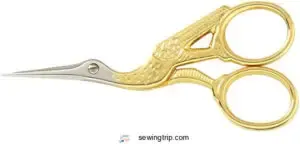 View On Amazon
View On Amazon Delving into the whipstitch‘s
- Joining fabric edges
- Securing hems
- Attaching appliqués
- Creating decorative finishes
Origin and Historical Use of Blanket Stitch
The blanket stitch boasts a rich history that will make you appreciate its longevity.
Dating back to ancient civilizations, this versatile stitch has adorned textiles for millennia.
You’ll find it gracing the edges of early blankets, clothing, and even decorative tapestries.
As cultures evolved, so did the blanket stitch, adapting to new materials and purposes.
It’s a clear example of human ingenuity, weaving its way through time with both function and flair.
Primary Functions of Whipstitch
The humble whipstitch is like the Swiss Army knife of hand stitches. You’ll find it’s a jack-of-all-trades in your sewing arsenal. Here are its primary functions:
- Sealing raw edges to prevent fraying
- Joining two pieces of fabric together
- Creating quick, sturdy hems
- Attaching appliqués for decorative flair
Whether you’re a novice or a seasoned pro, Whether you’re a novice or a seasoned pro, the whipstitch’s versatility makes it a go-to for various sewing project fabrics.
. It’s your trusty sidekick for both functional and aesthetic needs.
Primary Functions of Blanket Stitch
The blanket stitch is incredibly versatile.
You’ll find it’s a go-to for edge finishing, creating decorative trims, and protecting raw edges from fraying.
It’s like a bodyguard for your fabric’s edge!
This stitch also shines in appliqué attachment, allowing you to securely fasten decorative elements.
With various stitch variations, you can customize its look to suit your project’s needs.
Common Applications for Whipstitch
The whipstitch’s versatility is your sewing toolkit’s secret weapon.
You’ll find yourself reaching for it when appliquing delicate lace onto a bodice or joining two fabric pieces with a nearly invisible seam.
It’s your go-to for quick hemming jobs and can even tackle closure reinforcement.
Whether you’re working with lightweight silks or sturdy denims, this stitch adapts like a chameleon, making it a true jack-of-all-trades in your sewing arsenal.
Common Applications for Blanket Stitch
While the blanket stitch might sound cozy, it’s actually a versatile workhorse in your sewing arsenal. You’ll find this stitch stepping up to the plate in various projects, adding both function and flair. Here are some common applications where the blanket stitch shines:
- Securing appliqués with a decorative edge
- Finishing raw edges on blankets or fleece projects
- Creating durable buttonholes
- Adding a rustic touch to hems
- Embellishing garments or crafts with a distinctive look
Visual Appearance and Stitch Formation Differences
Now that you’re familiar with the basics, let’s take a closer look at the visual differences between these two stitches. You might be wondering, "How can I tell them apart at a glance?" Well, you’re in for a treat!
The whipstitch is like a spiral staircase, winding its way along the fabric edge. It creates a series of diagonal lines that resemble a candy cane stripe. On the other hand, the blanket stitch is more like a fence with posts. It forms a line of straight stitches with loops that extend over the edge, creating a decorative border.
When it comes to stitch direction, the whipstitch moves in a continuous line, while the blanket stitch alternates between vertical and horizontal movements. The thread loops in a blanket stitch are more pronounced, giving it a chunkier appearance compared to the sleeker whipstitch.
Technique and Execution of Whipstitch Vs Blanket Stitch
You’re about to discover the ins and outs of executing whipstitch and blanket stitch like a pro. We’ll break down the techniques step-by-step, from needle positioning to spacing tricks, so you can stitch with confidence and finesse.
Step-by-step Guide for Whipstitch
Needle in hand, you’re ready to master the whipstitch! This versatile stitch is your secret weapon for joining edges and creating decorative finishes. Here’s your step-by-step guide to mastering the art of sewing an elastic waistband, starting with Gathering Your Supplies.
- Thread your needle and knot the end
- Insert the needle from back to front, close to the edge
- Bring the needle over the edge and insert it diagonally
Step-by-step Guide for Blanket Stitch
Now that you’ve mastered the whipstitch, let’s tackle its fancy cousin: the blanket stitch. This versatile edging technique’s been around since grandma was a girl, and it’s still a crowd-pleaser. Here’s your step-by-step guide to nailing it:
| Step | Action | Pro Tip |
|---|---|---|
| 1 | Thread needle, tie knot | Double-thread for strength |
| 2 | Insert from back to front | Keep tension even |
| 3 | Loop thread under needle | Practice makes perfect |
| 4 | Pull through, repeat | Spacing is key |
Needle and Thread Positioning for Whipstitch
For a whipstitch that looks sharp and even, proper needle and thread positioning is key. You’ll want to:
- Hold the fabric edges together like you’re giving them a hug
- Keep your needle perpendicular to the edge, like a tiny soldier standing at attention
- Maintain consistent thread tension, as if you’re walking a well-behaved dog
- Angle your stitches slightly for that classic diagonal look
Needle and Thread Positioning for Blanket Stitch
Now, let’s turn our attention to the blanket stitch. This eye-catching technique requires a different approach to needle and thread positioning. Here’s a quick breakdown:
| Aspect | Whipstitch | Blanket Stitch |
|---|---|---|
| Needle Entry | Side to side | Top to bottom |
| Thread Path | Diagonal | L-shaped |
| Loop Formation | None | Forms loops |
Spacing and Tension Considerations for Whipstitch
For whipstitching, spacing and tension are your secret weapons for a polished look.
Aim for consistent stitch density by keeping your needle spacing even – about 1/8 inch apart works well for most projects.
Maintain a steady thread tension to avoid puckering or loose edges.
With practice, you’ll find your rhythm and create beautifully finished edges every time.
Spacing and Tension Considerations for Blanket Stitch
For the blanket stitch, spacing and tension are your best friends. You’ll want to keep your stitches evenly spaced and maintain consistent tension throughout. Here’s a quick guide to nail it:
- Space stitches 1/4 inch apart for a classic look
- Keep thread tension snug, but not too tight
- Adjust spacing for decorative variations
- Experiment with different thread thicknesses for fun effects
Strength and Durability Comparison
Now that you’ve mastered the techniques, let’s compare the strength and durability of whipstitch and blanket stitch. These stitches aren’t just pretty faces – they’re workhorses in your sewing arsenal!
| Feature | Whipstitch | Blanket Stitch |
|---|---|---|
| Tensile Strength | Moderate | High |
| Edge Reinforcement | Good | Excellent |
| Stress Distribution | Limited | Even |
When it comes to seam longevity, the blanket stitch is like the superhero of stitches. Its looped structure distributes stress evenly, Its looped structure distributes stress evenly, making it ideal for sewing projects for kids or charity that need to withstand rough-and-tumble use.
. The whipstitch, while not as strong, still holds its own in abrasion resistance. It’s perfect for quick fixes or holiday gift projects where you need a sturdy but simple solution. Remember, choosing the right stitch is like picking the perfect dance partner – it’s all about matching strength to your project’s needs!
Suitability for Various Fabrics and Materials
For hand stitching, not all fabrics are created equal. Understanding which stitch works best with different materials can make or break your sewing project, so let’s explore how the whipstitch and blanket stitch measure up across various fabrics and weights.
Ideal Fabrics for Whipstitch
While the whipstitch is versatile, it truly shines when working with certain fabrics. You’ll find it’s a go-to for:
- Lightweight fabrics like silk or chiffon
- Delicate materials such as lace or organza
- Sturdy textiles including denim and canvas
Don’t let its delicate appearance fool you – this stitch can handle heavier materials too. It’s like a chameleon, adapting to whatever fabric you throw its way. Just remember, practice makes perfect!
Ideal Fabrics for Blanket Stitch
The blanket stitch has a special affinity for certain fabrics. It’s particularly fond of felt applications and wool embellishments.
You’ll love how it adds a decorative touch to fleece edges. Cotton’s versatility also makes it a great canvas for blanket stitching.
Linen finishes benefit from the blanket stitch’s sturdy charm.
The blanket stitch isn’t picky – it’s like the Swiss Army knife of hand stitches.
Whipstitch Performance on Different Fabric Weights
Now that you’re familiar with the ideal fabrics for blanket stitch, let’s explore how the whipstitch performs across different fabric weights. You’ll find this stitch is quite the chameleon, adapting well to various materials. However, its performance can vary depending on the fabric’s thickness.
Here’s how the whipstitch fares on different fabrics:
- Lightweight fabrics: Whispers of thread dance gracefully along delicate edges
- Medium-weight fabrics: Your trusty sidekick for everyday sewing adventures
- Heavy materials: Tames even the most stubborn thick fabrics with gusto
- Stretchy fabrics: Flexes its muscles to keep up with elastic materials
Blanket Stitch Performance on Different Fabric Weights
With different fabric weights, the blanket stitch adapts like a chameleon. You’ll find it performs beautifully across the spectrum, from delicate silks to hefty denims. But remember, you’ll need to adjust your technique for each:
| Fabric Weight | Stitch Tension | Edge Reinforcement |
|---|---|---|
| Light | Loose | Excellent |
| Medium | Moderate | Very Good |
| Heavy | Tight | Good |
Don’t fret about bulk – this stitch knows how to play nice with thicker materials without compromising drape.
Adaptability to Stretchy Materials
For stretchy fabrics, you’re in for a treat. Both whipstitch and blanket stitch can adapt, but they’ve got their quirks.
The whipstitch’s flexibility shines on lightweight stretchy materials, allowing for better recovery properties.
Meanwhile, the blanket stitch offers superior seam stability on medium to heavy stretch fabrics.
Remember to adjust your tension and stitch length to maintain that perfect stretch factor. It’s like finding the right dance partner for your fabric.
Decorative Aspects and Aesthetic Appeal
You might think stitches are just for holding fabric together, but whipstitch and blanket stitch can be secret weapons in your sewing arsenal for adding flair to your projects. These versatile stitches serve functional purposes and also can transform plain edges into eye-catching designs, giving your creations a professional and polished look.
Whipstitch as a Decorative Element
The whipstitch is often used for practical purposes.
It’s also a hidden gem in your decorative toolkit. You can use it to add colorful accents, create texture, or form eye-catching patterns along edges.
Try experimenting with different thread colors and thicknesses to make your whipstitches pop. It’s like adding a little pizzazz to your project without breaking a sweat – who knew utility could be so stylish?
Blanket Stitch as a Decorative Element
The blanket stitch often steals the show as a decorative element. You’ll love how it adds a charming edge embellishment to your projects.
From folkloric designs to modern appliqué techniques, this versatile stitch creates eye-catching texture.
Play with color variations to make your work pop! It’s like adding a little pizzazz to your fabric’s edges, turning plain into spectacular.
Who knew a simple stitch could be such a showstopper?
Combining Whipstitch With Other Stitches
While the whipstitch shines on its own, it’s even more impressive when paired with other stitches. You can create eye-catching embellishments and unique patterns by combining it with:
- Running stitches for a delicate border
- Chain stitches to add texture
- French knots for a pop of dimension
Try layering whipstitches over a straight seam for a hybrid finish that’s both functional and fashionable. It’s like giving your project a stylish makeover – who said utility can’t be chic?
Combining Blanket Stitch With Other Stitches
The blanket stitch isn’t just a solo act; it plays well with others too!
You can create eye-catching designs by pairing it with running stitches, chain stitches, or even French knots.
Try using the blanket stitch as a border and filling it in with other decorative stitches.
Or, use it to secure appliqués and then embellish around the edges.
The possibilities are endless, so let your creativity run wild!
Color and Thread Options for Visual Impact
Anyone can elevate their stitching game with the right color and thread choices.
For whipstitches and blanket stitches, consider thread weight and stitch density to create eye-catching effects.
Play with color matching or bold contrasts to make your work pop.
You can even add embroidered details for extra flair.
Don’t be afraid to experiment; your creativity is the only limit when it comes to making these stitches truly shine!
Time Efficiency and Skill Level Requirements
Hand stitching takes time and skill. You’ll want to weigh the learning curve and execution speed of whipstitch versus blanket stitch to determine which one suits your project and sewing expertise best.
Learning Curve for Whipstitch
Moving from aesthetics to mastery, let’s tackle the whipstitch learning curve.
You’ll find it’s a breeze to pick up!
With a bit of practice, you’ll be whipping through fabric like a pro.
Focus on keeping your stitch size consistent and maintaining even thread tension control
.
Your hand position and needle type can make or break your technique.
Before you know it, you’ll be stitching in your sleep!
Learning Curve for Blanket Stitch
The whipstitch is fairly straightforward.
The blanket stitch might make you scratch your head at first.
Don’t worry, though! With a bit of practice, you’ll be stitching like a pro.
Focus on maintaining even tension and spacing as you work.
Try different fabric types to get a feel for how the stitch behaves.
Speed of Execution for Whipstitch
The whipstitch is a speedy little devil! You’ll be zipping along in no time, especially once you’ve got the hang of it. Your speed depends on a few factors:
- Your fingers dancing over the fabric like a pianist on keys
- The thread gliding through smoothly, no knots or tangles
- Your eyes laser-focused, guiding each stitch with precision
With practice, you’ll find your rhythm and whip through projects faster than you can say "hand-stitched masterpiece!
Speed of Execution for Blanket Stitch
While the blanket stitch might seem tricky at first, you’ll find its speed of execution improves with practice. The time it takes to complete a blanket stitch can vary based on several factors. Let’s break it down:
| Factor | Impact on Speed |
|---|---|
| Stitch Density | Higher density = Slower |
| Fabric Type | Thicker fabric = Slower |
| Hand vs Machine | Machine is faster |
| Practice Level | More practice = Faster |
| Project Size | Larger project = More time |
Suitability for Beginners Vs Advanced Sewers
Whether you’re a newbie or a seasoned pro, both whipstitch and blanket stitch have their place in your sewing toolkit.
Whipstitch is your go-to for quick, simple edge finishing – perfect for beginners dipping their toes in.
Blanket stitch, while a bit trickier, offers a decorative edge that’ll make your projects pop.
As you gain confidence, you’ll find yourself reaching for both, depending on your project’s needs and time constraints.
Frequently Asked Questions (FAQs)
Is whipstitch the same as blanket stitch?
While they’re both threads in the fabric of hand sewing, whipstitch and blanket stitch aren’t cut from the same cloth. You’ll use whipstitch for joining edges, while blanket stitch adds a decorative finish to raw edges.
What are three drawbacks of using a whip stitch?
You’ll find three drawbacks of using a whip stitch: it’s not as sturdy as other stitches, it can be visible on the right side, and it’s time-consuming. Plus, it’s tricky to keep your stitches even and consistent.
What is the difference between whipstitch and backstitch?
You’ll find whipstitch and backstitch quite different. Whipstitch wraps around edges, joining them with diagonal stitches. Backstitch creates a solid line by sewing backward, then forward. One’s for edges, the other’s for strength – choose wisely, seamster!
What is the benefit of whip stitching?
Got a seam that needs stitching? Whip stitch to the rescue! You’ll love how it joins edges seamlessly, hems like a pro, and even adds decorative flair. It’s versatile, easy to learn, and perfect for both beginners and pros.
Can whipstitch and blanket stitch be combined?
Combining whipstitch and blanket stitch can create a unique, decorative edge. Try alternating between the two stitches for a fun pattern, or use the blanket stitch to reinforce a whipstitched seam. It’s sew creative!
Which stitch is better for joining knitted pieces?
For joining knitted pieces, you’ll want to reach for the trusty mattress stitch. It’s your go-to for creating invisible seams that blend seamlessly with your knit fabric. You’ll be a knit-joining ninja in no time!
How do these stitches affect fabric stretch?
You’ll find these stitches aren’t exactly flexible friends. They can put a damper on your fabric’s natural give. The whipstitch’s tight grip might make things a bit stiff, while the blanket stitch offers a smidge more wiggle room.
Are there machine equivalents for these hand stitches?
You’ll find machine equivalents for Mastering Basic Stitches on your sewing machine.
. The zigzag stitch mimics the whipstitch, while the blanket stitch has a dedicated setting on many machines. Experiment with different settings to match hand-sewn looks.
Can these stitches be used for invisible mending?
Think of invisible mending like a secret agent – it’s all about stealth. You can use the whipstitch or blanket stitch to mend tears or holes, but it’s the thread color and stitch size that’ll keep it under wraps.
Conclusion
Now that you’ve got the lowdown on these two stitching superheroes, it’s time to ‘sew’ up the deal!
In the case of Whipstitch vs. Blanket Stitch differences, the choice ultimately depends on your fabric, project needs, and desired level of stitch stardom.
Whipstitch is perfect for quick fixes and invisible seams, while Blanket Stitch shines on thicker materials and as a bold embellishment.
Mastering both will take your sewing skills to the next level by Exploring Stitching Techniques.
.

